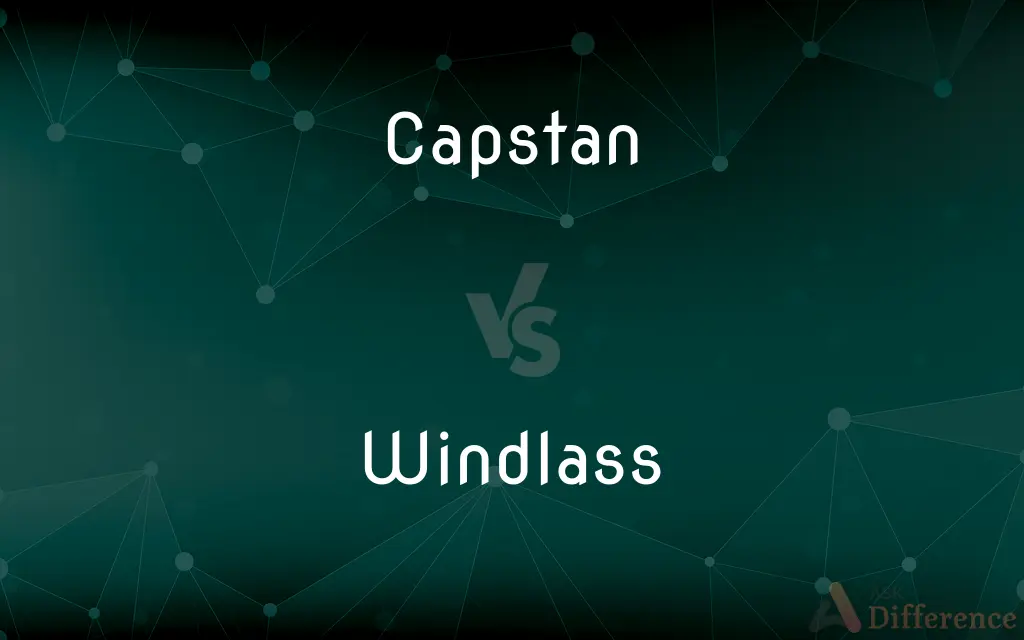Capstan vs. Windlass — What's the Difference?
By Urooj Arif & Fiza Rafique — Updated on March 11, 2024
A capstan, used for heavy lifting, rotates vertically and is common on sailing ships, while a windlass, for hoisting or hauling, rotates horizontally and is often found on modern vessels.

Difference Between Capstan and Windlass
Table of Contents
ADVERTISEMENT
Key Differences
A capstan is a vertical-axle rotating machine used historically on sailing ships for tasks such as moving heavy weights or ropes. Its design allows for multiple people to push on the bars (or "handspikes"), making it easier to perform tasks like hoisting sails or anchors. Whereas, a windlass is designed with a horizontal axle and is typically operated by a crank or motor, used for similar purposes but in a different mechanical layout, often seen in modern boats and ships for anchoring.
The capstan, by virtue of its vertical design, is more suited for operations where deck space is limited, as it requires less horizontal clearance. This design allows crew members to apply force from any direction, providing flexibility in tight spaces. On the other hand, the windlass requires more deck space for its horizontal layout but offers a more straightforward approach to winding or unwinding ropes or chains, often making it more efficient for tasks like raising anchors.
Capstans can be manually operated or powered by steam, electricity, or hydraulics, making them versatile for various applications beyond maritime use, including in industries like construction and mining. Windlasses, especially in contemporary settings, are often powered by electric or hydraulic systems, providing a more consistent and less labor-intensive operation, particularly suited for the repetitive task of raising and lowering anchors.
The mechanical advantage of a capstan is achieved through the leverage of handspikes and the drum's diameter, allowing for significant force to be applied by the crew. The windlass gains its mechanical advantage primarily through the gear ratio between the crank or motor and the drum, enabling it to lift heavy weights with less manual effort.
In terms of applications, capstans are not only found on ships but also in other settings requiring heavy lifting and pulling, like theater stage mechanisms and industrial sites. Windlasses, while predominantly associated with marine applications for anchoring purposes, can also be found in various lifting and pulling tasks in construction and other industries where horizontal pulling is required.
ADVERTISEMENT
Comparison Chart
Orientation
Vertical axle
Horizontal axle
Common Usage
Sailing ships, heavy lifting
Modern vessels, anchoring
Operation
Manually or powered, uses handspikes
Manually or powered, uses a crank or motor
Deck Space
Requires less horizontal space
Requires more horizontal space
Flexibility
Allows force application from any direction
More efficient in winding/unwinding
Mechanical Advantage
Through leverage of handspikes
Through gear ratio
Applications
Maritime, construction, theater
Maritime, construction
Power Source
Steam, electricity, hydraulics
Electricity, hydraulics
Compare with Definitions
Capstan
A device used on ships for heavy lifting with a vertical rotation.
The sailors used the capstan to hoist the anchor aboard.
Windlass
A device with a horizontal rotation used for hoisting.
The windlass efficiently raised the anchor with minimal effort.
Capstan
Not limited to maritime applications.
The capstan at the construction site made lifting heavy materials easier.
Windlass
Typically powered for ease of use.
The electric windlass made anchoring a simple task.
Capstan
Often operated by crew using handspikes.
The crew pushed against the capstan's handspikes to raise the sails.
Windlass
Most commonly found on boats for anchoring.
The boat's windlass was essential for managing the anchor during rough seas.
Capstan
Achieved through leverage and drum diameter.
The capstan's design allowed the crew to exert significant force with less effort.
Windlass
Suited for vessels with ample deck area.
The large deck accommodated the windlass without compromising space.
Capstan
Ideal for limited deck areas.
Despite the small deck, the capstan provided the necessary lifting power without occupying much space.
Windlass
Designed for optimal rope or chain management.
The windlass smoothly wound the anchor chain, preventing tangles.
Capstan
A broad revolving cylinder with a vertical axis used for winding a rope or cable, powered by a motor or pushed round by levers.
Windlass
The windlass is an apparatus for moving heavy weights. Typically, a windlass consists of a horizontal cylinder (barrel), which is rotated by the turn of a crank or belt.
Capstan
(Nautical) An apparatus used for hoisting, consisting of a vertical, manually or mechanically rotated cylinder around which the cable to be pulled runs.
Windlass
Any of numerous hauling or lifting machines consisting essentially of a horizontal cylinder turned by a crank or a motor so that a line attached to the load is wound around the cylinder.
Capstan
A small cylindrical shaft used to drive magnetic tape at a constant speed in a tape recorder.
Windlass
To raise with a windlass.
Capstan
(nautical) A vertical cylindrical machine that revolves on a spindle, used to apply force to ropes, cables, etc. It is typically surmounted by a drumhead with sockets for levers used to turn it.
Windlass
Any of various forms of winch, in which a rope or cable is wound around a cylinder, used for lifting heavy weights
Capstan
(electronics) A rotating spindle used to move recording tape through the mechanism of a tape recorder.
Windlass
A winding and circuitous way; a roundabout course.
Capstan
A vertical cleated drum or cylinder, revolving on an upright spindle, and surmounted by a drumhead with sockets for bars or levers. It is much used, especially on shipboard, for moving or raising heavy weights or exerting great power by traction upon a rope or cable, passing around the drum. It is operated either by steam power or by a number of men walking around the capstan, each pushing on the end of a lever fixed in its socket.
Windlass
An apparatus resembling a winch or windlass, for bending the bow of an arblast, or crossbow.
Capstan
A windlass rotated in a horizontal plane around a vertical axis; used on ships for weighing anchor or raising heavy sails
Windlass
To raise with, or as if with, a windlass; to use a windlass.
Windlass
To take a roundabout course; to work warily or by indirect means.
Windlass
A winding and circuitous way; a roundabout course; a shift.
Windlass
A machine for raising weights, consisting of a horizontal cylinder or roller moving on its axis, and turned by a crank, lever, or similar means, so as to wind up a rope or chain attached to the weight. In vessels the windlass is often used instead of the capstan for raising the anchor. It is usually set upon the forecastle, and is worked by hand or steam.
Windlass
An apparatus resembling a winch or windlass, for bending the bow of an arblast, or crossbow.
Windlass
To take a roundabout course; to work warily or by indirect means.
Windlass
To raise with, or as with, a windlass; to use a windlass.
Windlass
Lifting device consisting of a horizontal cylinder turned by a crank on which a cable or rope winds
Common Curiosities
Is a capstan suitable for limited deck spaces?
Yes, its vertical design makes it space-efficient for tight deck areas.
What is the primary use of a windlass on modern vessels?
Mainly for anchoring purposes, allowing easy raising and lowering of the anchor.
Can a capstan be powered by other means besides manual effort?
Yes, capstans can be powered by steam, electricity, or hydraulics.
Can a windlass be used for purposes other than anchoring?
While primarily for anchoring, windlasses can also be used in other lifting and pulling tasks.
What is the main purpose of a capstan on a ship?
To lift heavy weights or pull ropes, especially for sails and anchors.
Are windlasses found in non-maritime applications?
Yes, they can also be used in construction and other industries for lifting and pulling.
How does the design of a capstan allow for flexibility in use?
Its vertical orientation allows force to be applied from any direction.
How does a windlass differ from a capstan in orientation?
A windlass has a horizontal axle, while a capstan's axle is vertical.
What type of power sources can operate a windlass?
Windlasses are commonly powered by electricity or hydraulics.
Can a windlass handle both rope and chain?
Yes, windlasses are designed to handle both rope and chain efficiently.
How do sailors operate a manual capstan?
By pushing against handspikes inserted into the capstan, providing leverage.
How does the deck space affect the choice between a capstan and a windlass?
Capstans are chosen for limited deck spaces due to their vertical design, while windlasses require more horizontal space.
What provides the mechanical advantage in a capstan?
The leverage from handspikes and the diameter of the drum.
What makes a windlass efficient in winding and unwinding?
Its horizontal layout and gear ratio make it efficient for managing ropes or chains.
Are capstans still used on modern ships?
Yes, capstans are used on modern ships, especially for specific lifting tasks.
Share Your Discovery

Previous Comparison
Accommodating vs. Accommodative
Next Comparison
Stable vs. LiveryAuthor Spotlight
Written by
Urooj ArifUrooj is a skilled content writer at Ask Difference, known for her exceptional ability to simplify complex topics into engaging and informative content. With a passion for research and a flair for clear, concise writing, she consistently delivers articles that resonate with our diverse audience.
Co-written by
Fiza RafiqueFiza Rafique is a skilled content writer at AskDifference.com, where she meticulously refines and enhances written pieces. Drawing from her vast editorial expertise, Fiza ensures clarity, accuracy, and precision in every article. Passionate about language, she continually seeks to elevate the quality of content for readers worldwide.














































